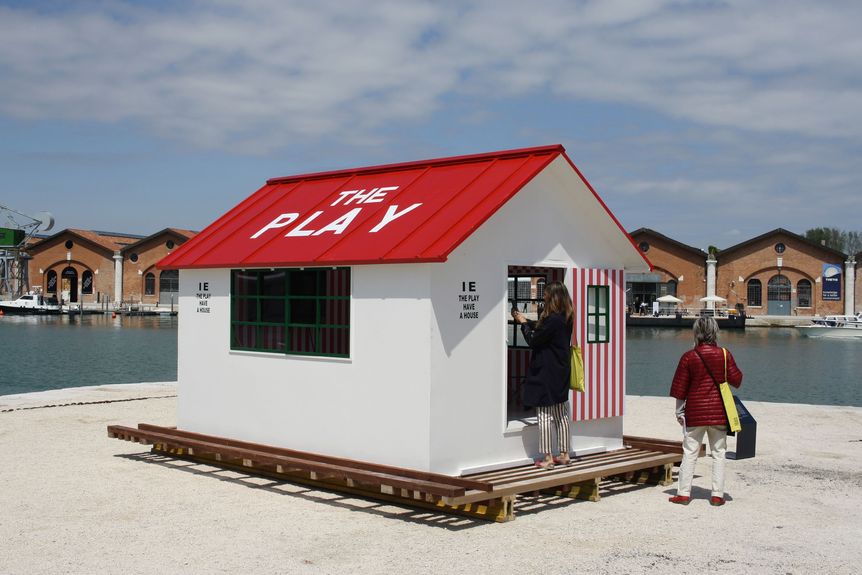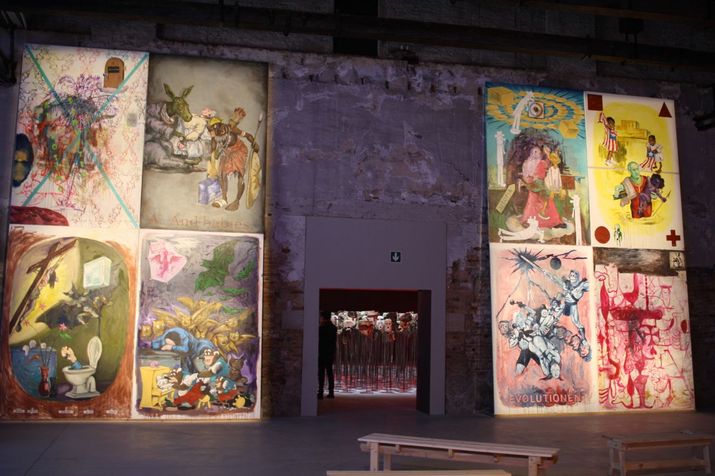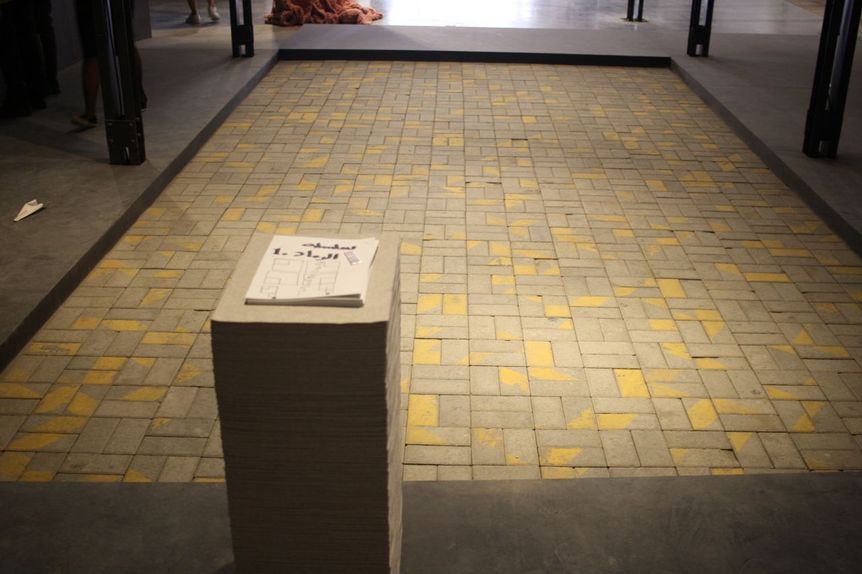
R
E
V N
E
X
T
57th Venice Biennale, Part 3: National Pavilions in the Arsenale
Between visits to the national pavilions and the central exhibition, “Viva Arte Viva,” there were also performances to see and participate in during the opening week of the 57th Venice Biennale. Japanese collective The Play’s “house boat” was floating in the water on the first day but had moved from its location the next; perhaps the group took it for a test paddle around the Arsenale’s calm waters. Also in the Arsenale was Nevin Aladağ’s performance Raise the Roof (2007/17), which features seven performers dancing in stiletto heels on copper sheets while they are listening to their favorite dancing songs—which only they can hear. The platforms they are gyrating on are mic’d and become like drums, collectively forming a percussive chorus. And in Giardini, I witnessed David Medalla and his partner Adam Nankervis conducting an initiation ceremony for three new members of the Mondrian Fan Club, which saw them being baptizing in primary-colored pigments (like those used in India for the Holi festival) in a ritual that mixed Christian, Hindu and Modernist symbolism. But back to the national pavilions—these ones were located in the Arsenale.
The interior of the China Pavilion, “Continuum – Generation by Generation” with shadow-puppet theater screens created by Wang Tianwen with Tang Nannan and Wu Jian’an.
China Pavilion: “Continuum – Generation by Generation”
Artist and curator Qiu Zhijie organized the China Pavilion in 2017, which is good news for those who may have seen disappointing recent editions. “Continuum – Generation by Generation,” was inspired by the Chinese concept of buxi, an unrelenting energy or life force, and featured individual and collaborative works by four artists: Tang Nannan, Wu Jian’an, Wang Tianwen and Yao Huifen. Tang showed videos inspired by Chinese myths dealing with waterways and landscapes. Yao Huifen is an expert in Suzhou embroidery and creates contemporary versions of the revered craft. Wang Tianwen is a Shaanxi shadow-play master, and Wu Jian’an’s laser-cut copper-sheet sculptures rose like totems throughout the space. Many works referenced ancient and celestial themes, and they came together in the collaborative, multimedia shadow-play performance created by the four artists and the curator himself, Continuum – Removing the Mountains and Filling the Sea, with musicians and performers combining traditional methods and digital projections. The exhibition very consciously follows in the footsteps of Chinese intellectuals through history interested in folk art and practices. The cacophonous atmosphere of the China Pavilion this time around had real intention and engaging effects.
New Zealand Pavilion: Lisa Reihanna
A decade in the works, Lisa Reihana’s 23.5-meter-long digital projection, In Pursuit of Venus [infected] (2015–17), filled the length of the New Zealand Pavilion with an idealized, pastoral South Pacific landscape. As the landscape—which is based on an actual French scenic wallpaper from 1804—scrolls across the space from right to left (or in a way that assimilates the act of the viewer slowly turning to the right), a series of 80 vignettes, in live-action capture, narrate European explorations of the Pacific (including Captain James Cook’s voyages on the Endeavor). This unfolds over 30 minutes. The video begins with scenes of pre-colonial life in Oceanic civilizations, and then depictions of early moments of contact, and the changes brought by intercultural trade and marriage. Things become progressively darker and more violent. Cook himself morphs, from man to a quasi-deity before he is eventually killed in a trivial dispute. Accompanied by a complex score, the work is incredibly detailed, in its research and in the live-action performances happening on screen, as well as in its technical realization. The experience of such a massive, moving visual surface, whose narratives are impossible to view entirely from any one vantage, become a larger metaphor for colonial history itself.
Philippines Pavilion: Lani Maestro & Manuel Ocampo
“The Spectre of Comparison” brought together the works of two artists: Lani Maestro, who makes contemplative and poetic installations, and Manuel Ocampo, known for his hilariously brutal, expressionistic canvases about the Philippines history. As a phrase, the pavilion’s title comes from the Philippines’ national novel, Noli Me Tángere, by José Rizal, and also refers to Benedict Anderson’s suggestion that nationalism springs from making comparisons. Unfortunately, the spectre of comparison for the artists was not a cohesive one. Lani Maestro’s two neon sculptures—one of which read “No Pain Like This Body / No Body Like This Pain” in red neon, and the other “If you must take my life, spare these hands” in blue neon, mounted high on the walls—evoked a world of pain and suffering, but in the most legible of formats. There was a cluster of wooden benches in the center of the space that comprises Meronmeron (2017), also a work by Maestro that was meant to offer, as benches do, a resting or conversing place in the middle of the space. By contrast, Ocampo’s pair of massive canvases on both sides of the doorway, one of which was Torta Imperiales (2017), had dramatic presence and compelled sustained attention at their comic-grotesque catalogues of Goya-inspired horrors and cartoon kitsch. The fourth wall featured three paintings from the mid-1990s by Ocampo, among them Cooks in the Kitchen (1993/1997), a gruesome diptych featuring three white men being tortured, sodomized and disemboweled by three figures in blackface, with the words: “The Development of Abstract Act / Immigrant Version” written across the top. Love it or hate it, at least there was more than just the effect of misery to consider in Ocampo’s canvases, and there were benches that were at least useful for contemplating them.
Turkey Pavilion: Cevdet Erek
Sound and spaces, sound in spaces, sound of spaces—these are Cevdet Erek’s interests, which he has been exploring in his ongoing “Room of Rhythms” series that combines architectural and sonic insertions. The Turkey Pavilion is titled “Çın,” which is an onomatopoeic word in Turkey similar to “ding,” and Erek filled the space with a wooden structure with a long scaffold ramp and stairs, echoing Venetian bridges. The 35-channels of directional loudspeakers mounted on posts at the top of the bridge filled one half of the space with rhythmic, percussive sounds—some sounding like the banging of metal or a simulation of tinnitus, and others that, upon closer hearing, are actually tiny snippets of words in whispered, underground poetry. The other half of the space featured more stairs and a fenced-off area. It was dark and not really activated by sound or activity. It feels a bit simplistic to say that the whispering and ringing in one’s ears in one half of “Çın,” and the gloomy sense of imprisonment in the other could be seen as a metaphor for life in Turkey these days. However, tellingly, in the pavilion’s liner notes, Erek uses the phrases like “series of events / great intensity / most recent jolt,” “tinnitus / no cure / face history / or / keep masking it,” and “an individual / representing a country / an individual’s voice.” Consider that half of the installation was a bit dismal and under-utilized, and that the words are whispered like a series of furtive communications. If there have been tens of thousands imprisoned in the last year and many more forced to lower their voices to just above the audible, then perhaps Erek’s installation is very much of the moment, in its own hushed way.
Singapore Pavilion: Zai Kuning
The Singapore Pavilion, “Dapunta Hyang: Transmission of Knowledge,” features Zai Kuning’s 17-meter-long rattan sculpture of the outline of a ship’s hull, held together with red string and a lot of beeswax that’s dripped expressively onto an aluminum sheet below. Its symbolic cargo is the piles of books, also wrapped in red string and coated in beeswax in a way that appears as if its contents have been preserved for the future. The installation relates to the story of the eighth-century voyage of the first Malay king, Dapunta Hyang Sri Jayanasa, through the Srivijaya kingdom and the legacy of the orang laut, the sea people of the Riau Archipelago. The walls are lined with 24 contemporary photographs of people from this community—who are also considered the original inhabitants of Singapore itself—in a celebration of a pre-modern culture and heritage that is dying out through the neglect and discrimination that has come with the city-state’s modernization. Though Zai Kuning has been working with the orang laut community since 2001, the black-and-white images showing mak yong dance-drama rituals and other glimpses of life in the community can’t shake their ethnographic qualities—which brings a host of problematic dynamics to bear, as in any artistic or scholarly project about the representation of indigenous communities. The presence of documentary images drags Zai Kuning’s boat sculpture back into some muddy ethical waters about representation, and I found myself wishing that only the fictional, imaginary parts of the project were on view. In the best of cases, an artistic representation carries a project’s real-world research in its hold, without having to make its contents so legible.
United Arab Emirates Pavilion: “Rock, Paper, Scissors: Positions in Play”
It took a while to figure out what was going on—and what was not—in the UAE Pavilion, “Rock, Paper, Scissors: Positions in Play,” curated by Hammad Nasar. There was a set of ten wooden oars suspended from the ceiling, a work by Mohamed Yousif, entitled Al insiyabiyya bil majadeef that al maa (“The flow of underwater paddles”) (1995/2017), and one of the black steel columns in the space was covered in Sara al-Haddad’s crocheted pink-yarn sculpture, Can’t you see how I feel (2017). There was a painting by Lantian Xie of a West Bank-like olive grove, sitting on bubble paper, accompanied by a list of “events” happening during the Biennale, including live music by a Filippino band from Hong Kong playing in the Hotel Danieli lobby and a seagull carrying away french fries in its mouth. There was also Vikram Divecha’s video of people washing a rock and his floor sculpture of re-arranged bricks taken from a bus stop. From a fort-like perch above, occasionally someone launched a paper airplane, whose page carries a short story about an exodus of inaminate objects by Deepak Unnikrishnan. At the back of the space was a stack of photocopied 1985 poetry ’zines titled Silsilat Al-Ramad and by Nujoom Alghanem, each with an artfully adhered piece of individually wrapped chewing gum. There were more contributions—visual and textual—in the accompanying publication, which is where the pavilions’ ideas begin to take on more coherence, rooted in the importance of play and absurdist gestures in UAE artists’ practices, beginning with Hassan Sharif and Abdullah al-Saadi. Like walking into a primary school playground at recess, there was so much “play” happening in the UAE Pavilion, and all at once, that the individual gestures were less transgressive—as art—than they might be otherwise. As a pavilion “Rock, Paper, Scissors” was headed in a direction that comes off as very self-indulgent—as if the pavilion-parent is spoiling its artist-children. Maybe these “kids” feel they deserve to be spoiled a bit while on vacation in Italy after not receiving much love at home? Regardless, although the artists at play might have ignored the visitor, they at least seemed to be enjoying themselves.
Indonesia Pavilion: Tintin Wulia
Tintin Wulia had ambitious plans for the Indonesia Pavilion, “1001 Martian Homes,” which we heard about in an interview that ArtAsiaPacific published in our latest issue (103, May/Jun 2017). I was sorry to see them not go well, at least in terms of the execution of the project, in the opening days of the Biennale. The project imagines the family stories that will be told in the future, at a time of Martian colonialization, about our time on Earth today. The project is taking place in nearly identical form in both Venice and in a space in Jakarta, so that the imagery produced by the interactive video pieces in one place travels to the other. The embedded monitors with eyes on the staircase up to the first level, entitled Under the Sun (2017) was suitably unnerving, and was the result of people looking through the tiny peephole at the top of the stairs (showing a studio-like room) in the Jakarta version. I didn’t manage to experience the two-meter-diameter orb that seemed to be glowing with LED lights, an interactive sculpture called Not Alone (2017), which projected an image onto the ceiling, but I hope many viewers both in Venice and Jakarta will. Beyond technical challenges, the issues with the Indonesia Pavilion are on a structural level, as the space is too small to have multiple levels and multiple works, and the white-painted walls and red-carpeted staircase almost immediately looks stuffy in the dusty, high-traffic environment of the Arsenale. The setting, unfortunately, resembled a trade-fair booth rather than a futuristic world. The reality is that the organizations and individuals responsible for the Indonesia Pavilion need to do more in the future to enable artists to present their artworks in the best light at the Venice Biennale.
HG Masters is editor-at-large of ArtAsiaPacific.
To read more of ArtAsiaPacific’s articles, visit our Digital Library.










